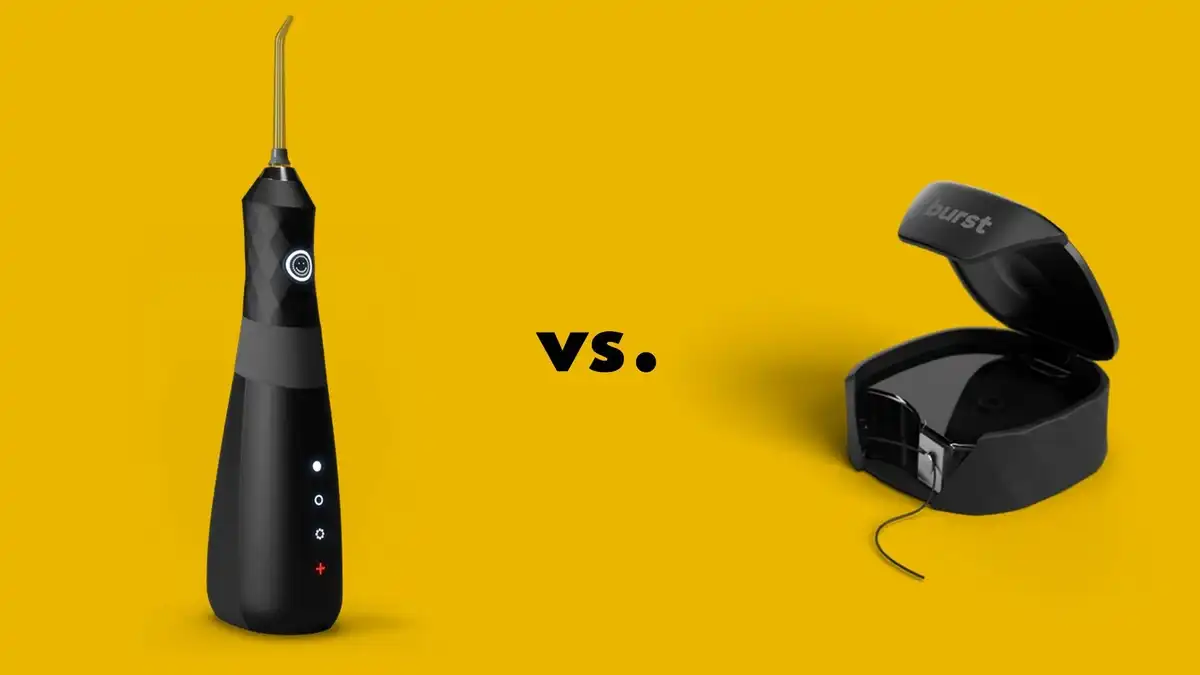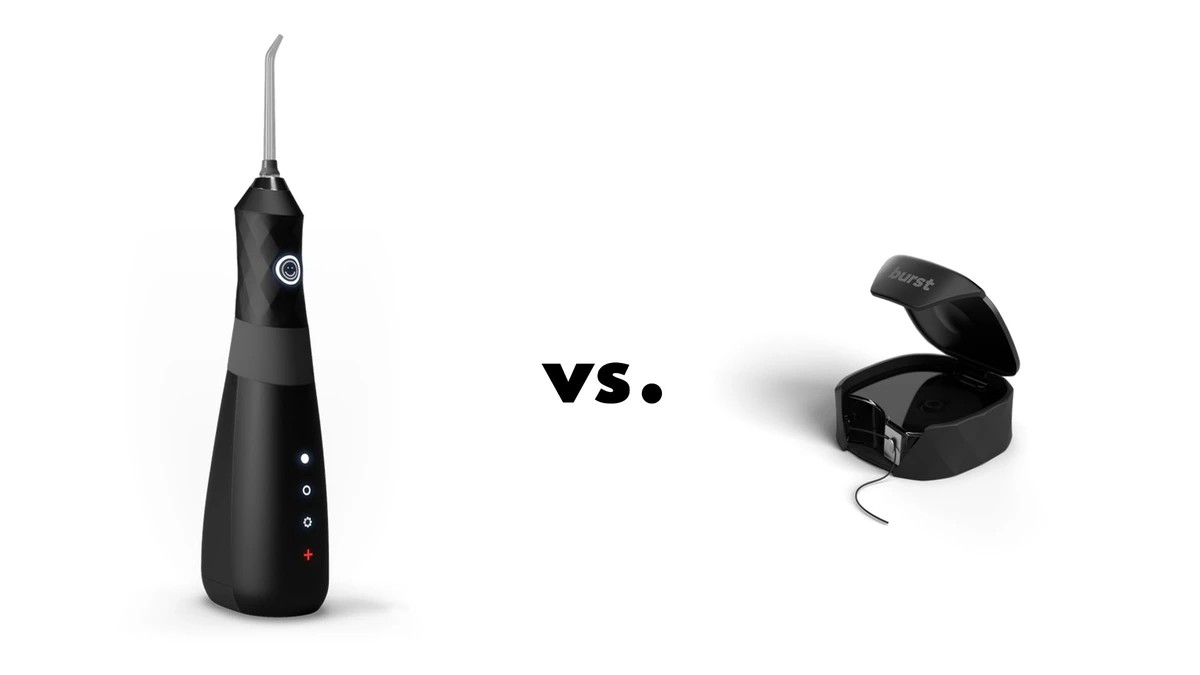Is Water Flossing Better Than String Flossing?


Have you ever wondered if a water flosser was better than string floss? When it comes to comparing flossing vs. Waterpiks, there are some big benefits to consider.
Water flossers are an oral irrigating device that cleans your teeth with a steady stream of water instead of a strand of floss. Some people call them water flossers, water jets, or, Waterpiks. Ultimately, they work by aiming a stream of water at your teeth and gums.
If you’re one of those people who hate using dental floss anyway, you might be in for a pleasant surprise when you find out the truth about water flossers.
Traditional String Dental Floss
Flossing is something you’re supposed to do every day. Technically for it to work, you need to be wrapping the string dental floss snuggly against your tooth in a “C” shape and then rubbing it up and down the side and under the gums.
But flossing can only reach about 1-3mm into your gum pocket. If you have gum disease with periodontal pockets deeper than 4mm, regular floss can’t help you clean them. It also can’t clean the concavities on the sides of your tooth roots. When you use floss, you can clean between teeth and just under the edges of your gums.
More than likely, you won’t be able to get any deeper than 3-4mm into your periodontal pockets. This can be an issue if you have periodontal disease aka gum disease.
Water Flossing
Oral irrigating devices are special tools that you can use in conjunction with flossing (or some people use it instead of flossing) to reach down into deeper periodontal pockets.
Technically…you’re not supposed to replace regular flossing with a water flosser. BUT…some people benefit more from using water flossers than they do string floss. Oral irrigating devices like the BURST Water Flosser use a stream of water to blast away plaque and keep gums healthy. Since your gums like to be stimulated, water flossing helps to keep them happy and is effective in reducing bleeding.
Personally, I see a huge difference in my patients who use water flossers over string floss. Their teeth and dental appliances are usually cleaner, and they tend to get better results after periodontal treatments like deep cleanings.
Water flossers are an adjunctive tool to use in addition to your regular floss, but a lot of people use them to replace flossing altogether. That being said, water flossers are not meant to prevent cavities; they’re designed to help prevent gum disease!
But the truth is, anybody can use a water flosser. In fact, they’re a whole lot easier than dental floss if you’re cleaning around things like:
- braces
- orthodontic appliances and retainers
- dental implants
- dental bridges

The Goal Of A Water Flosser
The goal of a water flosser is to prevent periodontal infections by keeping gums healthy. Water flossing does not prevent cavities, but it can help prevent gum disease and combat inflamed gums. Some people benefit from it more than others.
Which One Is Better For You?
Is water flossing better than traditional string floss? The water floss vs. string floss debate is one that goes back years. It used to be that people thought water flossing was a gimmick and that you could only use regular floss to really clean your teeth. But today’s scientific research — that’s actual clinical studies, people — shows water flossing can clean deeper inside of gum pockets in individuals who have periodontal disease.
Although water flossers are technically an “additional” tool you use in conjunction with traditional floss, some people that use them find they don’t need string floss at all.
In reality, research studies repeatedly suggest that using a water flosser is superior to conventional flossing.
That being said, here are a few reasons to choose one over the other:
Traditional Flossing
- Less messy
- Cheaper
- Fine for healthy gums
- Works in gum pockets up to 2-3mm
Water Flossing
- Cleans around braces, bridges or implants
- Easy to reach around braces
- Reaches further under gums to clean periodontal pockets
- Works in pockets up to 7+mmIdeal for people with dexterity issues
Gum Disease Prevention
Gum disease — aka periodontitis — is an inflammatory response to plaque bacteria next to your gum tissues. You need to clean that buildup away every day so that your immune system doesn’t start attacking it as an infection. One of the best ways to flush the biofilm away from gums and out from under gum pockets is with a water flosser.
Using water lavage truly reduces bleeding gums, keeping your gingiva happy and healthy.
Since your toothbrush or traditional floss can’t reach deep under the gums, adding a water flosser to your routine will flush away any loose bacteria (so that it can’t turn into tartar!)
Here are other reasons to use a water flosser:
Do You Get Deep Cleanings
If you’re one of those people who have “periodontal pockets” or have had a deep cleaning in the past, stop everything you’re doing and get a water flosser.
When you start using a water flosser, you’ll be able to clean between teeth, under gums, around bridges, implants, and (safely) power wash all of those existing restorations in your mouth.
When it comes to cleaning under the gums, your Waterpik will reach further and help you keep periodontal infections at bay. You might even become addicted. And before you know it, you might not need a cleaning every three months!
Do You Have Bleeding Gums
Irrigating your gum lines with a water flosser vs traditional floss provides a more thorough removal of bacteria. You’ll be able to improve bleeding within a couple of weeks.
People with gum disease tend to get heavy bleeding when they brush and floss. A water flosser can help reduce bleeding gums and make cleaning your teeth more comfortable. Plus, the extra stimulation helps too!
Do You Have Heavy Tartar Buildup
Tartar is caused by plaque that isn’t removed regularly. It calcifies into a hard substance that you can’t brush or floss away. Water flossing can help you lower how much tartar you get in the first place!
Do you get a lot of tartar buildup between your dental cleanings? All tartar is, is calcified plaque. So, if a water flosser makes it easier for you to remove plaque along your gums, between teeth, or under your dental bridge, then it’s a no brainer!
Cleaning Braces Or A Permanent Retainer
Flossing around your brackets, wires, or a retainer that’s glued onto your teeth can be a daunting process.
Fixed orthodontic appliances add tons of extra surfaces in your mouth for plaque to stick to. Sometimes, you’ll even see those little white circles on your teeth because of plaque not getting cleaned off. A water flosser is way easier than using string floss around everything.
Fortunately, a water flosser can reach EVERYWHERE in your mouth, without having to thread a string of floss through each little area.
Sounds convincing, doesn’t it?
Implant Care And Maintenance
If you’re one of the thousands of people who has invested in a dental implant, you know you need to take really, really good care of it. Dental implants require extra special care, since the most common cause of their failure is a type of gum disease. You need to be cleaning them really good, every day. If you have an implant-supported bridge or All-on-4 denture, then a water flosser is the best way to reach under your restoration.
Water flossing is perfectly safe for your implant. Since peri-implantitis (the implant version of gingivitis) is the leading cause of implant failure — and water flossing prevents inflamed gums and removes plaque — it’s the perfect sidekick for your new smile!
So Are Water Flossers Better Than Traditional Floss?
When it comes to water flossers vs. traditional floss, using a water flosser is easier, more accessible, and proven to reach deeper under your gums.
Yes, water flossing is messy. But with a little bit of practice, you may find that your mouth is healthier because of your addiction to the device (which is something hardly anyone says about regular floss!)
Water flossers can reach places easier than regular floss, especially if you have gum pockets. Plus, they massage and stimulate gum tissue to help keep it healthy. Research supports better results from using Waterpiks over regular floss. Switching to a water flosser is scientifically proven to be better at cleaning away plaque biofilm than conventional floss.
What more reason do you need to finally take the leap? Learn more about how to use a water flosser to see if its right for you.

Make your inbox smile!
Subscribe






